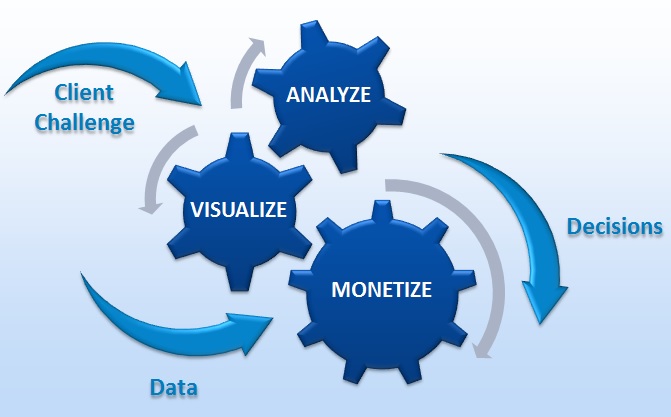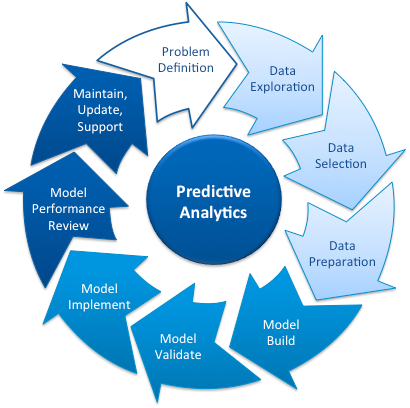Cognilytics provides unique “Data to Decisions” approach, expertise and templates that deliver innovative and monetize-able insights to our clients. We utilize proprietary processes and methodologies to deliver value-added solutions. Cognilytics is able to support our clients with an end-to-end process based on an extensive library of customizable templates, which we use on our engagements.
There are multiple steps in the predictive analysis process. At Cognilytics, we have captured these steps in our Cognilytics AVM™ model. Our mantra for this process is Analyze-Visualize-Monetize. Of course our approach to Big Data is foundational across each of these key steps to drive decisions and value.

The three phases of this approach are defined below:
Analyze
Our analysts always begin with establishing an understanding of the business problem and generate the hypotheses to solve that challenge. They can then sample the data from the analytical data store appropriate for analysis. There are multiple methods for sampling data within the solution.
Visualize
Analysts can draw a set of visuals to illustrate potential key drivers and solution sets. They also develop additional “What-if” scenarios and socialize initial findings with business stakeholders to ensure solution relevance. With the right visual tools, Cognilytics analysts have advanced visualizations for use in exploring relationships within the data. In this step, the analyst can identify data quality problems, discover initial insights and form data-driven hypotheses from formerly hidden information that is revealed. As an outcome of this step, the solution also provides multiple methods to create and modify variables for use by the predictive algorithms.
Monetize
Monetization is the key final step where we apply unique predictive modeling to derive a solution to the business challenge. There are multiple algorithms such as regression analysis, K-means clustering, time series analysis, machine learning algorithms, etc. that we apply. Once the models are finalized, they then work to ensure all tests are implemented according to plan with appropriate KPIs and Dashboards for success tracking. Finally, we help our clients implement the necessary continuous improvement process for predictive analytics that underlies the AVM approach.

Our seven step CAPstone (Cognilytics Analytical Process) delivery methodology encompasses the AVM™ approach. We use this methodology to ensure we deliver high quality analytical solutions that meet the needs of our customers.
A description of the seven steps to the CAPstone (Cognilytics Analytics Process) is as follows:
- Problem Definition
- Design Thinking approach to clearly identify the problem to be solved
- Key stakeholders are identified and engaged in the definition of the goals, as well as the success criteria
- Workshops to identify the best visualizations for the goals of the project
- Toll-gate: clear problem definition, and success criteria for the project
- Data Preparation
- Data Exploration: identify data sources, explore using visualization
- Data Selection: identify data variables to feed into model and visualization, agree on independent and dependent variables
- Data Preparation: create modeling data set
- Data quality assessment and remediation of issues
- Toll-gate: High quality data set ready for modeling/visualization
- Model Build
- Compare alternative modeling approaches
- Identify model performance metrics and success criteria
- Select modeling approaches to be used to solve the problem
- Select tools to be used (SAS, R, Python, etc.)
- Document approach
- Build models and test performance
- Toll-gate: Acceptable performance on a consistent set of model tests based on passing success criteria
- Model Validation: First/Second line of defense
- Complete model documentation
- Effective challenge
- External review/replication/benchmarking (e.g. by ERM)
- Toll-gate: externally approval of first and second line of defense for model validation
- Model Implementation
- Define implementation criteria around speed, cost, scalability, etc.
- Choose production platform
- SDLC for automation
- Model migration (including any recoding required for production environment)
- Migration process through Development, QA, and finally Production environments
- UAT
- Toll-gate: successful migration to an automated run in the Production environment meeting the implementation criteria defined
- Model Performance Review
- Ongoing performance monitoring and review
- Trend and back testing reports
- Any needed stress testing
- Toll-gate: results that exceed the hurdles required to pass performance reviews
- Maintenance, Continual Improvement and Support
- Model review, re-calibration, refresh, re-build